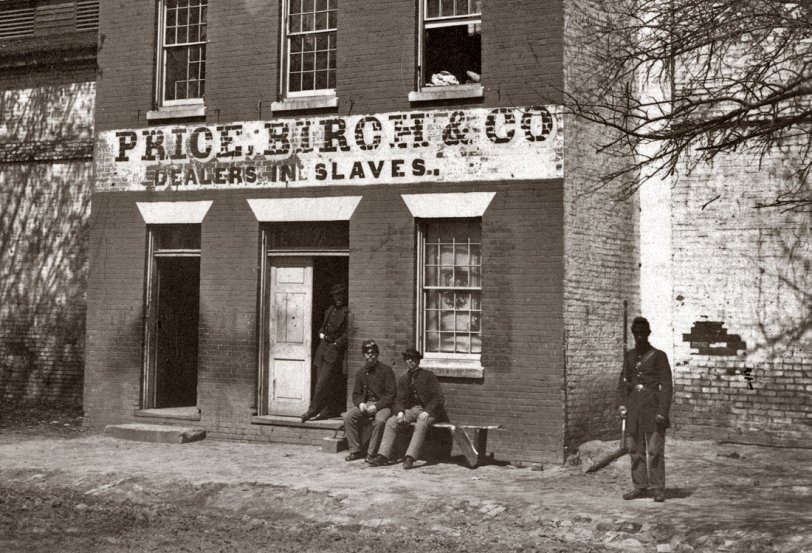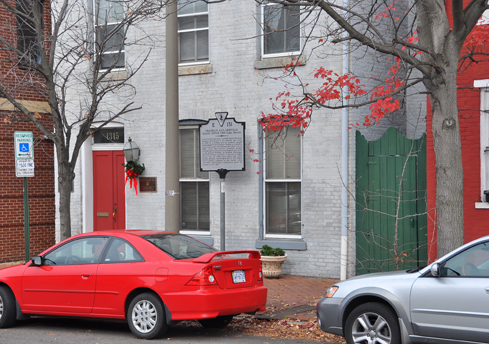


Framed or unframed, desk size to sofa size, printed by us in Arizona and Alabama since 2007. Explore now.
Shorpy is funded by you. Patreon contributors get an ad-free experience.
Learn more.

- Baldwin 62303
- Baldwin VO-1000
- Cold
- No expense spared
- Tough Guys
- Lost in Toyland
- And without gloves
- If I were a blindfolded time traveler
- Smoke Consumer Also Cooks
- Oh that stove!
- Possibly still there?
- What?!?
- $100 Reward
- Freeze Frame
- Texas Flyer wanted
- Just a Year Too Soon
- WWII -- Replacing men with women at the railroad crossing.
- Yes, Icing
- You kids drive me nuts!
- NOT An Easy Job
- I wonder
- Just add window boxes
- Icing Platform?
- Indiana Harbor Belt abides
- Freezing haze
- Corrections (for those who care)
- C&NW at Nelson
- Fallen Flags
- A dangerous job made worse
- Water Stop
Print Emporium
Price, Birch & Company: 1865

Union Army guard at Price, Birch & Co. slave pen at Alexandria, Virginia, circa 1865. Detail of albumen print. View full size. Photograph by Andrew J. Russell.
Solomon Northrup Was Here
This was the slave dealership Northrup went through in 1841 on his was to New Orleans. At the time, Alexandria City and Alexandria County were still part of the District of Columbia. They were retroceded back to Virginia in 1846. Four years later, the slave trade was abolished in the District of Columbia.
+145
Below is the same view from December of 2010.

Great Intentional Irony
The building still exists with slightly different details (such as the window frames). In a wonderful bit of intentional irony, the building is now the headquarters of the Northern Virginia Urban League. I spoke to a historian about the building to verify that it was indeed the same one as in the photograph and he confirmed that it was. He also said that during renovation, they found iron attachments in the basement that may have been used to anchor shackles.
Birch and Birchett
I am wondering if there is a relationship between the names Birch and Birchett (also Burchett, Burchette and Birchette). I am wondering if the other names evolved from the root name, in some way I do know that Birchetts were large slave holders in St. Petersburg, Virginia.
Price, Birch, and Co. Slave Trading
Do you know the names of the "Price" and "Birch" involved in this? I've seen this before and am a "Birch" myself and wondered about this.
still more info
I accidentally left the address off of that last comment. It's listed as "1315 Duke Street"
Here is the location in google maps. This is only a few miles from where I currently live. Perhaps I'll try to get down there this weekend and shoot some shots of the front of the building as it appears now. If so, I'll post a note and link here.
-gary
[Thanks Gary. Here's a satellite view of the address. - Dave]
more info
More info, via:
http://oha.alexandriava.gov/oha-main/oha-natl-register.html
Franklin and Armfield Office
Click to enlarge
Built in 1812 as a residence for General Andrew Young, this was the office building of the former interstate slave trading complex which stood on the site from 1828 to 1861. By 1835 Franklin and Armfield controlled nearly half the coastal slave trade from Virginia and Maryland to New Orleans. In 1846 the property was sold to a Franklin and Armfield agent, George Kephart, whose business became "the chief slave-dealing firm in [Virginia] and perhaps anywhere along the border between the Free and Slave States." After 1858, the slave pen was known as Price, Birch, and Co., and their sign can be seen in a Civil War era photograph. The business was appalling to many, especially to active abolitionists in Alexandria, where the large Quaker population contributed to a general distaste for slavery. Several abolitionists' accounts survive which describe the slave pen and the conditions encountered therein. Behind the house was a yard containing several structures, surrounded by a high, whitewashed brick wall. Male slaves were located in a yard to the west, while women and children were kept in a yard to the east, separated by a passage and a strong grated door of iron. The complex served as a Civil War prison from 1861 to 1865, and housed the Alexandria Hospital from 1878 to 1885. It was later apartments, and was renovated as offices in 1984.
Slave pen photos
The exterior view is by Andrew J. Russell, who has hundreds of Civil War era photographs in the Library of Congress archives. The interior shots, each half of a stereograph pair, are unattributed but might have been taken by him also. The things on the floor look like watering troughs for horses and may have been stored there by the Union Army.
























On Shorpy:
Today’s Top 5